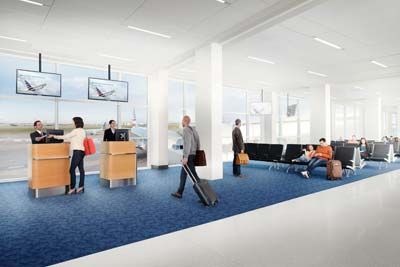Mary Schlangenstein (c) 2013, Bloomberg News
DALLAS_ American Airlines Group Inc., formed Monday by the combination of AMR Corp. and US Airways Group Inc., is poised to rise on confidence that the world’s largest carrier can avoid the pitfalls that dragged down other mergers.
The stock may reach $39 by 2015, estimated Hunter Keay, a Wolfe Research Inc. analyst, while Jamie Baker of JPMorgan Chase & Co. sees Fort Worth, Texas-based American rising to $37. Holders of US Airways, which closed last week at $22.55, will get shares of the new company in a one-for-one exchange.
Doug Parker takes the helm as chief executive officer with lessons learned in creating the current US Airways in a tie-up with America West Holdings Corp. in 2005. As he seeks $1 billion in new revenue and savings, he plans to smooth technology bumps by using the reservation system at AMR’s American, the bigger airline, and has union accords in place to ensure labor peace and predictable costs.
“They are in a good position,” Savanthi Syth, a Raymond James Financial Inc. analyst, said in an interview. “That’s not to say they won’t have any hiccups, but they have their own merger experience and they’ve watched what’s worked and hasn’t worked for others. They will be a formidable competitor.”
American’s shares began trading Monday under the ticker AAL. The merger comes as AMR emerges from two years in bankruptcy protection under the deal, and CEO Tom Horton will step aside to become chairman until the first annual meeting.
Parker, 52, said last week he hopes to beat his $1 billion goal. That sum matches Delta’s initial 2008 target in buying Northwest Airlines Corp., and trails the $1.1 billion to $1.2 billion sought in the 2010 merger creating United Continental Holdings Inc. from UAL Corp. and Continental Airlines Inc.
United and Delta, now the world’s biggest airlines, both suffered merger-related bumps.
Delta tumbled 37 percent in seven trading sessions after announcing the Northwest deal as investors faulted its synergy goal as too little, and it later raised its sights to $2 billion. Last month, United set a cost-cutting goal of $2 billion by 2017 after posting the sixth-best return among 10 carriers in the Bloomberg U.S. Airlines Index.
American expects to replicate the financial performance of the merged US Airways-America West, which “outperformed the industry from day one,” according to US Airways President Scott Kirby, who will take that role at the combined carrier. The airline should lead U.S. competitors in returns and other financial metrics in less than three years, he said.
“What investors care about is our financial performance,” Kirby, 46, said in a Dec. 6 interview. “I feel pretty confident we can deliver again.”
Parker and Kirby have seen their own integration setbacks. Tempe, Ariz.-based US Airways still lacks a unified contract for pilots from its two predecessors, and the 2007 post-merger switch to a single reservation system included computer faults that delayed flights and shut down airport kiosks.
“We learned a lot,” Parker said in a Dec. 4 interview. “I’m reluctant to say we have it figured out. We’ve had the benefit of each doing one ourselves, and we have seen others and the successes and challenges they’ve had. We’ve studied those and are trying to make sure we get the best practices in place.”
US Airways traded at a discount to Delta and Chicago-based United last week in part because of “overhyped and oversimplified integration fears” about the American tie-up, Keay said in a note to investors.
United still hasn’t reached combined contracts with all of its work groups, and suffered a series of computer system failures and flight delays into 2012. Those reverses “have soured the confidence of many investors,” JPMorgan Chase’s Baker said in a Dec. 5 note.
“We see cause for optimism” with the new American, wrote Baker, who is based in New York.
At last week’s implied $17.8 billion, American Airlines Group would have been the second-largest U.S. airline by market value, trailing only Delta’s $24.2 billion as of Dec. 6.
American creditors, employees and other stakeholders will own 72 percent of the combined company, while US Airways shareholders will get the rest. The new American will operate 6,700 daily flights to 336 locations in 56 countries, with a fleet of 1,511 mainline and regional jets.
US Airways gained the support of American’s unions for the merger four months after beginning its pursuit of the carrier, and secured preliminary contract agreements that provide for raises starting today.
The pilot agreement sets a timetable and method to mesh seniority lists, the pivotal issue for unionized captains and first officers and the one that has kept employees for America West and US Airways from moving to one contract.
“People are going to be watching us from day one,” Kirby said. “We have high expectations from our employees for sure, from investors and our customers, and that’s fair. I don’t think people are going to give us a lot of slack if we don’t deliver.”






